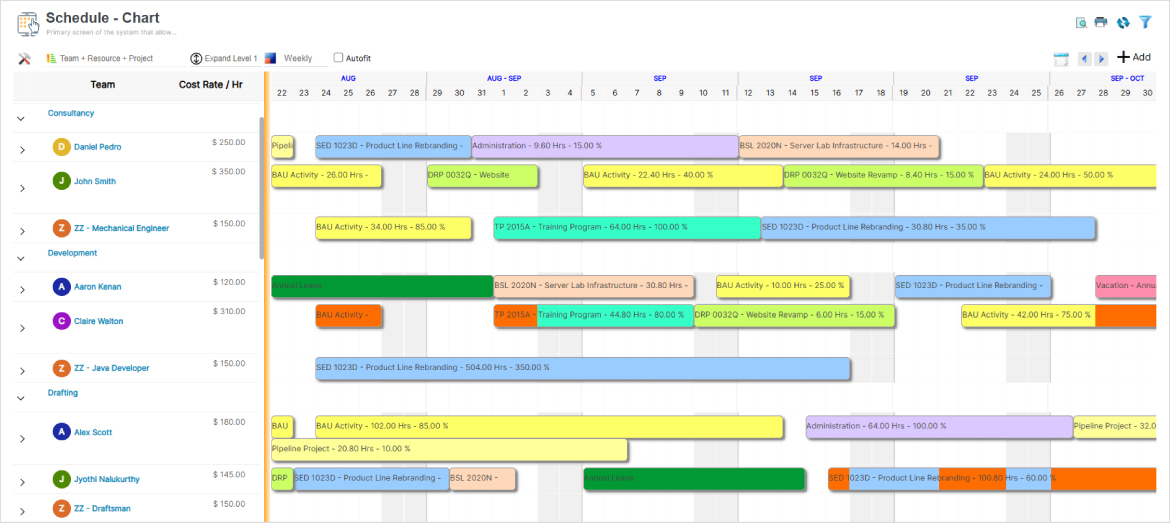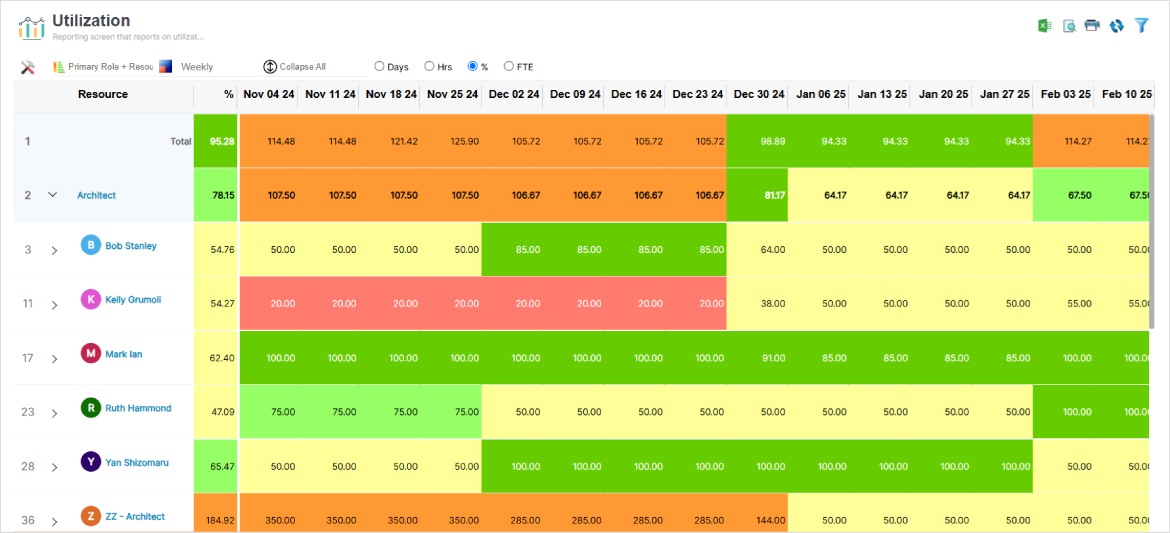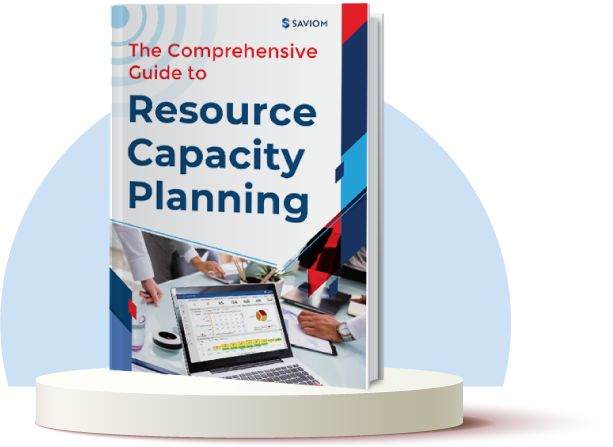According to Grant Thornton’s State of Work in America survey, “51% of employees reported burnout in the past year, i.e., a 15% increase from 2023.”
The above statistic underscores a concerning trend in the workplace. This significant rise in burnout rates suggests a deeper issue tied to overutilization, affecting employee well-being and organizational health. This can be attributed to factors such as increased workloads, poor work-life balance, and inadequate employee wellness.
If left unaddressed, these challenges can disrupt workflows, hinder productivity, inflate costs unnecessarily, and jeopardize project delivery.
Therefore, it is crucial for organizations to implement effective strategies to monitor and optimize workforce utilization levels, enhance revenue margins, and maintain overall resource health.
In this blog, we will delve into the definition of overutilization, its various types, and effective strategies to mitigate it.
Let’s begin!
What is Overutilization?
Overutilization refers to organizations using their resources, such as personnel, time, finances, equipment, and tools, beyond an optimal threshold for an extended period. This often leads to employee burnout, increased wear and tear on equipment, higher maintenance costs, diminished efficiency, reduced productivity, and more.
For instance, consider a customer service team in a bustling call center facing unexpected surges in call volumes due to a recent marketing campaign.
To manage these influxes, the team consistently works overtime, which gradually becomes the norm rather than the exception.
Despite efforts to uphold productivity standards, prolonged stress and extended hours lead to employee burnout. This results in diminished morale, increased absenteeism, and a noticeable decline in the quality of customer service.
What was initially intended to manage peak demand efficiently has led to overutilization. As the team’s time and energy are stretched too thin, it results in negative repercussions, not just for employee well-being but also for customer satisfaction.
Now, let’s explore the different types of overutilization.
Types of Overutilization
Overutilization impacts more than just people; it also affects assets, finances, and other resources. Read on:
Production Overutilization
Production overutilization refers to operating a manufacturing facility at maximum capacity for extended periods without adequate downtime or maintenance. This practice often results in equipment failures, higher maintenance costs, and reduced product quality, impacting the company’s growth and reputation.
Employee Overutilization
Employee overutilization occurs when personnel are consistently assigned to projects way beyond their capacity for a prolonged period, leaving little room for work-life balance. This often results in stress, burnout, and reduced productivity, eventually leading to high attrition rates.
Financial Overutilization
Financial overutilization occurs when a company relies heavily on borrowed funds to sustain operations without a clear repayment strategy. This can lead to financial instability, increased risk of bankruptcy, and jeopardize the organization’s long-term survival.
Resource Overutilization
Resource overutilization occurs when organizations utilize raw materials, machinery, or equipment beyond optimal levels. This can result in increased maintenance costs, shortened operational lifespans, frequent breakdowns, reduced efficiency, and lower output quality.
Read More: What is Resource Utilization? A Complete Guide to Improve Business Efficiency
Now that we’ve covered the types of overutilization let’s delve into the factors that cause it.
Factors Causing Overutilization in Firms
Overutilization in firms stems from various reasons, including organizational inefficiencies and external demands. Here are a few common contributing factors:
Lack of Capacity Foresight
When organizations fail to anticipate or plan for future workload demands and resource availability, they often overcommit resources to projects, resulting in overutilization. If left unchecked over time, this can escalate stress levels, lead to employee burnout, reduce performance and efficiency, and lower output quality.
Unanticipated Demand or Scope Creep
Unexpected client demands or uncontrolled scope expansions can force teams to stretch beyond their limits. Without adjustments in timelines or resources, employees often find themselves working additional hours, leading to overutilization. Prolonged strain results in burnout, reduced productivity, and sub-par output.
Poor Resource Allocation
In a siloed organization, managers often lack full visibility into the resource pool. As a result, misallocation of resources, such as overloading a few high-performing employees while underutilizing others happens. This leads to inefficiencies and burnout, thereby jeopardizing organizational productivity.
Read More: What is Resource Allocation, and Why is it Important?
Inadequate Number of Skilled Resources
A shortage of qualified personnel puts excessive pressure on existing employees to cover skill gaps. This issue often arises from poor workforce planning, hiring delays, or employee attrition. This can cause employee exhaustion, reduced productivity, and negatively impact profitability.
Unreasonable Deadlines & Expectations
Setting unrealistic deadlines or expecting constant high performance without considering workforce limits leads to chronic overwork. This undue pressure disrupts work-life balance, causing stress and fatigue. Over time, it results in low productivity and an overall decline in performance.
Now that we understand the causes let’s examine how overutilization impacts firms.
Impact of Overutilization on Firms
Overutilization of resources directly impacts organizational productivity, profitability, and sustainability. Let’s explore these consequences in detail.
Decline in Workforce Productivity
When employees are overwhelmed with excessive workloads, their efficiency declines, and tasks take longer to complete. The constant pressure divides their focus, making it difficult to maintain accuracy and attention to detail. As a result, errors become more frequent, workflow slows down, and overall productivity suffers.
Compromise in Work Quality & Missed Deadlines
Overutilized employees struggle to maintain work quality as they rush to meet demanding schedules. This increases the risk of mistakes, inconsistent deliverables, and failure to meet deadlines. These issues weaken client trust, damage the company’s reputation, and threaten long-term business sustainability.
Frequent Unplanned Absenteeism
As overutilization persists for a prolonged period, employees may experience exhaustion and burnout, prompting them to take more sick days or unplanned leave to recuperate. This unscheduled absence disrupts workflow, increases the workload of remaining team members, and perpetuates a cycle of reduced productivity.
Read More: How to Reduce Absenteeism in the Workplace
Escalating Burnout Levels
Continuous overexertion without sufficient breaks or recovery periods prevents employees from rejuvenating both physically and mentally, ultimately contributing to burnout. This persistent burnout level reduces individual efficiency, weakens team collaboration and overall workplace morale.
Rise in Attrition Rates
When employees are overworked for extended periods, they may experience burnout, marked by emotional exhaustion and decreased motivation, significantly impacting their morale. Consequently, this pushes them to seek opportunities in organizations that offer better conditions and a healthier work environment.
Now that we’re aware of the consequences of overutilization, let’s explore strategies to avoid it and enhance the firm’s overall performance.
10 Strategies to Avoid Overutilization Among Resources
Overutilization can exhaust teams, hinder employee productivity, and lead to burnout if not addressed properly. Here are 10 effective strategies to help companies prevent it and ensure a healthy workload balance.
Foresee Pipeline Resource Requirements
One of the most effective ways to prevent overutilization is by accurately forecasting future resource demands. By analyzing upcoming projects, managers can anticipate workload fluctuations and allocate resources, ensuring no team is overwhelmed.
This proactive approach helps identify the necessary skills, roles, and capacity needed in advance, reducing the risk of overloading employees due to last-minute demands. It also enhances productivity and minimizes stress and burnout, fostering a more sustainable work environment.
Assess Capacity vs. Demand Gap
To prevent overutilization, managers must regularly evaluate whether resource capacity aligns with project demands. If workloads exceed available capacity, employees may be forced to take on excessive tasks, leading to burnout and reduced efficiency.
By identifying gaps between required skills and available resources, organizations can take proactive measures such as retraining/upskilling, hiring, or redistributing tasks to prevent overburdening specific individuals. Maintaining this balance ensures that workloads are distributed effectively, preventing overallocation and minimizing stress.
Read More: 10 Key Capacity Building Strategies to Boost Organizational Productivity
Ensure Competent Resource Allocation
Poor resource allocation is a major driver of overutilization, as mismatched assignments can lead to unnecessary workload strain. Assigning tasks based on skills, experience, and availability ensures that no individual is overwhelmed while others remain underutilized.
When managers have a clear understanding of their team’s expertise, they can distribute work more effectively, preventing burnout caused by excessive or unsuitable workloads. Thus, a well-structured allocation strategy optimizes workload balance, ensuring sustained productivity without overburdening employees.

SAVIOM’s multidimensional scheduler helps managers adjust allocations in real time to ensure balanced workload distribution.
Prioritize Projects & Tasks
Failing to prioritize projects and tasks can lead to resource overutilization, as employees may end up juggling too many tasks. By structuring work based on urgency, impact, and ROI, managers can ensure that critical tasks receive the necessary attention.
This prevents employees from being overwhelmed with excessive workloads and allows for a more strategic distribution of effort. Thoughtful task prioritization not only prevents burnout but also enhances overall project success by ensuring that key objectives are met without exhausting the workforce.
Set Realistic Utilization Targets
Organizations must set resource utilization targets at organizational, project, and individual levels to determine if the resources are optimally utilized against their capacity. Failure to do so risks operational inefficiencies, increased costs, diminished productivity, and more.
For example, managers may set full-time employee utilization targets at 75-80% to ensure they’re not overutilized or overworked. In contrast, contingent workforce utilization benchmarks can be set at 100% as they are hired for specific projects and are expected to contribute at full capacity based on their defined roles.
Implement Suitable Resource Optimization Techniques
In a multi-project environment, managers risk overburdening key team members, leading to burnout and project delays. By implementing suitable optimization techniques like resource leveling and smoothing, managers can prevent these issues and ensure optimal resource utilization.
For projects with flexible timelines, managers can use leveling techniques to adjust task start and end dates based on resource availability. In contrast, for time-constrained projects, resource smoothing allows managers to reallocate workloads or bring in additional staff to maintain task schedules and enhance overall productivity.
Read More: What is Resource Optimization? A Complete Guide to Improve Project Delivery
Facilitate Flexible Work Options for Employees
According to Jobera, “61% of workers have considered quitting due to inflexibility at work.”
Companies that don’t offer flexible work options are likely to face high attrition rates, as employees may feel overutilized and burnt out. Managers can enhance productivity by offering flexible remote or hybrid work arrangements and encouraging necessary breaks.
When employees have more autonomy over their workload and are not stretched thin, they tend to be more engaged and deliver higher-quality work. This flexibility boosts motivation, leading to a more positive attitude and stronger organizational commitment.
Take Employee Feedback Regularly
Poor workload distribution can result in decreased productivity, increased employee stress levels, higher employee turnover rates, and other negative consequences. To prevent these issues, managers can conduct regular one-on-one meetings, surveys, or team discussions to gather insights.
This allows managers to develop effective strategies for adjusting and managing workloads. When employees feel heard, valued, and appropriately utilized, they are more motivated, engaged, and dedicated. This, in turn, enhances individual performance and contributes positively to overall organizational success.
Read More: How Can Your Work Culture Improve the Employee Experience?
Encourage Cross-Training to Redistribute Workloads as Necessary
During peak workloads and tight deadlines, managers often over-extend themselves to ensure milestones are met. This constant pressure can lead to fatigue, stress, and burnout, affecting overall efficiency. Without proper workload distribution, delays become inevitable, putting critical projects at risk.
To prevent this, organizations should implement cross-training programs that equip employees with the skills to step in during resource shortages or high-demand periods. This fosters a culture of knowledge-sharing and builds a more agile, resilient, and productive workforce.
Invest in Resource Management Tools
Without resource management tools, workload distribution becomes inconsistent, leading to overutilization of key employees while others remain underutilized. To address this, organizations should invest in software that aligns with their demands and enhances resource efficiency.
The ideal solution should include features such as capacity planning, forecasting, time tracking, real-time BI dashboards, etc. These capabilities provide actionable insights into resource utilization, enabling managers to optimize allocation, adjust workloads, and maintain steady productivity.
Read More: How Can You Make Data-Driven Decisions with Resource Management Software?
Now, let us move on to see how resource management software can help mitigate overutilization in detail.
How does Resource Management Software Help Avoid Overutilization?
A futuristic resource management software offers advanced features that help avoid resource overutilization and maintain a healthy workload balance. Here’s how:
- The tool provides enterprise-wide visibility into resource attributes such as skills, availability, utilization, etc. This enables them to quickly identify overworked resources and redistribute tasks to prevent overutilization and maintain balanced workloads.
- Moreover, the tool’s up-to-date competency matrix helps managers assign the right people to the right projects based on their skills, ensuring optimal resource utilization.
- The software’s forecasting and capacity planning features help managers anticipate upcoming workloads and secure suitable resources to prevent overutilization.
- The tool offers real-time utilization reports and color-coded heat maps, allowing managers to identify and course-correct overutilization of resources. Additionally, forecast vs. actual reports firms identify and assess variances and take appropriate measures to optimize utilization levels.

SAVIOM offers up-to-date utilization reports and color-coded heatmaps to help managers identify instances of overutilization and take corrective measures promptly.
Final Thoughts
As we now understand, overutilization is not just harmful to firms; it’s also counterproductive. When employees are overutilized, it disrupts their work-life balance, leading to stress and decreased productivity. Therefore, managers must prioritize workload balance and fair distribution to sustain employee well-being and organizational profitability.
Ready to build an optimally utilized workforce that drives long-term organizational success?
The Glossary
Read More: Glossary of Resource Workforce Planning, Scheduling and Management











